How to Create the Best Blog Page Design
Planning and creating your business’s website can seem like a daunting task. Knowing what pages your website will need can help streamline the process and better organize your business goals.
This article will help show you how to design a blog page as well as provide some of the best blog page layouts to help inspire you. It’ll also touch on how this page can tie into your business’s goals and overall website goals. By the end, you’ll have plenty of blog page design ideas to get you started.
Recommended: WordPress is geared toward helping business owners create a successful blog. Learn more by reading our How to Build A Content Focused Website article.
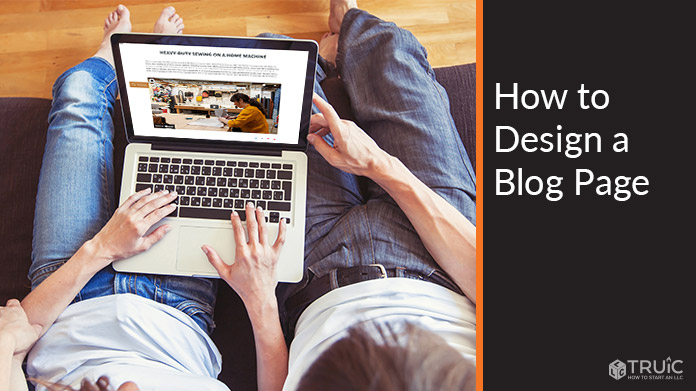
Before You Begin
Knowing which website builder is a good fit for your business blog design will help ensure you have all the tools you need to create its blog page. Check out our Best Website Builder review to get started.
Along with this guide, check out these other helpful articles to learn what each website builder offers and how to start building your own beautiful — and successful — blog page.
Understanding the Goal of Your Blog Design
The first step in planning an engaging blog page for your business website involves having a general idea of what you’d like to accomplish with this page. You can then apply these goals to your blog as well as to your business and its website as a whole.
Once established, these goals will help you decide how to design your blog page to best interact with your target audience.
Identifying Your Business Blog Goals
Having clear goals for your blog will help you measure the overall effectiveness of your entire website. Importantly, they should reflect the goals of your business as a whole. Check out our What Makes a Good Website guide for a detailed breakdown of how best to identify your goals.
Once you determine your overall business goals, it’s time to identify specific goals for your blog page. These will vary from business to business and blog to blog. Finding the goals that fit you and your business’s brand story is key to achieving the overall success of your blog and website.
Here are some good questions to ask yourself to help you identify your blog design goals:
- What type of business do you have? Most businesses use a blog page to help tell their brand story. Artists use blog pages to discuss their particular medium and often include tips as well as behind-the-scenes tidbits. Knowing what type of business you have will help clarify your target audience and the information they’ll most want to read about.
- What kind of goods or services do you provide? Your blog could provide another great place to discuss the products you offer. A vintage clothing store, for example, might use its blog to highlight the journey behind sourcing its offerings. Perhaps its owner traveled to a small town and discovered a rare artifact at a yard sale. Because your business and its offerings have a unique story, knowing what you sell can help you connect with what potential customers want to know more about.
- What kind of growth and engagement do you want? The main goal of a blog is to engage with readers. How can you keep them coming back for more? Do you want readers to follow you on social media as well? Would you like readers to have the ability to leave comments on your blog posts? Think about how you’d like to nurture the interaction between you and your target audience, and then brainstorm ways to keep them involved in both your blog and your business.
Your answers to these questions will help you clarify what sort of blog design your business website needs. They’ll also help you focus on how to design your blog page to better achieve your goals.
After answering these questions, it’s time to connect your blog page goals to a tangible way of measuring progress toward achieving them.
Using the right website builder for your business can make all the difference. Check out our Best Website Builder review to learn more.
Measuring Blog Design Success
Having goals is a great start, but reaching them can feel complicated. The best way to ensure you achieve your blog design goals involves making specific and measurable targets with tangible timelines and relevance.
- Be Specific: A specific goal for your blog page could be to publish four posts per month.
- Make It Measurable: A measurable goal could involve tracking your blog visitor data with a target of 50 visitors per week.
- Make It Attainable: While this may prove challenging, make sure you create realistic goals for your blog page. If you have a particularly large goal, break it down into smaller, more achievable milestones.
- Stay Relevant: All of your blog page objectives should help you achieve your website and business goals. If you run a coffee shop, for example, your blog shouldn’t discuss fashion or other topics beyond the scope of your business.
- Ensure It’s Time-Based: Setting a deadline for specific goals provides a clear indicator of achievement. A great time-based goal might be to have 100 followers of your blog by the end of the first month after its launch.
Once you have a set of specific blog page goals with a realistic timeline, make sure they tie back to the overall goals of your website and business.
Aligning Blog Goals and Business Goals
Now that you better understand your specific blog goals, make sure they’re relevant to both your business and website. Refer to our What Makes a Good Website guide for more details on creating clear goals for your business website.
Now, set your blog page goals alongside your business goals. Do your blog page goals support your overall business goals? Will your blog page effectively help you meet your website goals? If your blog page goals seem to veer off in another direction, revise them to ensure they align with both your website and business goals.
Once all of your goals work together, it’s time to dive into what your blog will need to successfully engage your target audience. We’ll discuss how your blog page’s content and design can help achieve this.
Determining Your Blog Content and Design
While your blog page isn’t typically the first thing visitors see when they arrive at your website, it should still make a good impression. The key is providing a balance of information and creativity.
Your blog page should include details about you and your business as well as a structure that helps visitors find other information with ease. Adding certain key elements, such as tools readers can use to follow you on social media and specific calls to action (CTAs), can help promote your blog page’s success.
Designing the Best Structure for Your Blog Layout
A clean and well-organized blog page will benefit your website overall. Good general design concepts can help keep visitors entertained while allowing them to easily find the information they seek.
When considering the structure of your blog page, try to keep two key aspects in mind. The first is the general layout of the blog page itself — how you organize posts and how easy it is for visitors to find the blog entry they want to read. A simple flow works best. There’s no need to clutter your blog’s landing page with too many posts, which can overwhelm visitors. A strong layout will allow the visitor’s eye to flow naturally down the page. You’ll also want to ensure your newer posts appear at the top as no one wants to scroll through outdated posts to reach the latest one.
The second key aspect to consider relates to how you structure your individual blog posts. Specifically, what’s your target length and what other elements do you need to include to engage your readers? As a best practice, keep it simple. Aim to break up any large blocks of text with images to help visually tell your story.
It also can prove helpful to use internal links in your posts to guide visitors to other parts of your website. If the main goal of your blog involves increasing awareness of your online store, for example, an internal link can make it easy for readers to find your product page.
For more information about identifying your website goals, check out our How To Structure a Website guide.
Creating Engaging Content for Your Blog Layout
Some may argue that creating engaging content is the sole purpose of a blog. But, that’s often easier said than done. Coming across as authentic and honest when engaging your target audience can prove tricky.
Crafting enticing titles can help you get readers excited to click on your posts. Make them brief, yet catchy so people feel compelled to click through.
Another successful way to create authentic, engaging content is to find and focus on your area of expertise. This should come naturally — especially since your area of expertise likely serves as the foundation of your business.
You should have extensive knowledge about your chosen subject as well as a passion for the topic. If you have both, it’ll come across in your writing. Why? Because the more you care about something, the easier it is to get others to care about it, too. Your charisma will be contagious.
Yet, creating engaging content requires more than simply finding a trend you think will interest your target audience. You represent the most valuable part of this blog, and your readers will want to hear what you think. This is a great time to market yourself. The more people want to know what you have to say, the more keen they’ll be to explore your entire website and possibly purchase goods or services from you.
Remember to also encourage interaction with your blog. While it might feel terrifying to put yourself out there, how else will you know what your readers really connect with if you don’t engage them? The comment section isn’t your enemy — it’s a great way to invite support, form professional relationships with readers, and receive feedback. But, you should always feel welcome to delete any upsetting or negative comments.
Most importantly, keep going! A successful blog is a consistent blog. Trust in yourself, your story, and your talents. You have something to offer, and people will connect with that.
Incorporating Key Elements for Success
Once you hone in on the right structure and content for your blog page, it’s time to see what other key elements you can add to promote its success.
Here are several useful elements you may want to consider adding:
- Images: The human eye likes to travel around a web page. If readers click on a lengthy blog post and only see huge chunks of text, they might not want to read it all. Adding images to tell your story can help break up the page into more digestible parts. But, ensure these images look professional and you have the rights to use them on your blog page.
- Videos: For more informative blogs, videos can provide a useful tool for demonstrating some of the information you want to convey. If you have a unique product and want to showcase all it can do, a video offers a great way to do so. Or, if you want to create a more visual blog, you might consider using videos as some or all of your posts.
- Internal Links: These embedded links not only help visitors navigate your website, but also communicate the information they need to know when clicking on them. Having such links within your blog posts can help steer readers to your newsletter or sales pages. But, always ensure the internal links in your posts remain up to date because broken links can frustrate your readers.
- Calls to Action: These most commonly appear as buttons site visitors can click, inviting them to “Sign Up,” “Read Now,” or take another action. On a blog page, CTA buttons could encourage readers to subscribe to your blog or purchase an item featured within a post.
- Social Media Icons: These can appear in your site’s header and/or footer, making it easy for readers to click on them to follow your business on social media platforms. You also can attach these icons to individual blog posts to enable your readers to easily share your posts on their own social media feeds. Think of your business’s social media accounts and blog page as a two-way street. Promote your blog in your social media posts and encourage readers of your blog to follow your social media accounts. This’ll help keep readers engaged and up to date.
- Comments: It’s a good idea to enable a comments section on your blog. While this may seem terrifying, it’s a great way to engage with readers. You can use the comments section to receive feedback, learn if readers seek something in particular, or answer any questions that might arise. Having an open form of communication can build trust between your readers and your brand.
- Contact Forms: If a comments section feels a little too overwhelming, a contact form also can enable your readers to send you a message. They also provide a great way to stay connected with your visitors and should always include a thank-you message.
- “Follow” Badges: Most website builders will allow you to place a “follow” badge or connect a widget that performs the same general function. This not only encourages people to follow or subscribe to your blog to receive updates when you publish new posts, but also offers other useful features to help you gain repeat readers.
- Spell-Check Functionality: While most website builders already include this feature, it never hurts to double-check your spelling and grammar before you publish a blog post.
Adding these key elements to your blog page can help it succeed by more effectively telling your story, thoughtfully engaging your target audience, and collecting the data you need to measure your achievements.
Reviewing Successful Blog Page Examples
Sometimes it’s more helpful to see success in action. Here are six examples of engaging blog pages built using various website builders. We’ll provide visuals for each as well as a brief explanation of what makes them so effective.
Best GoDaddy Blog Page Examples
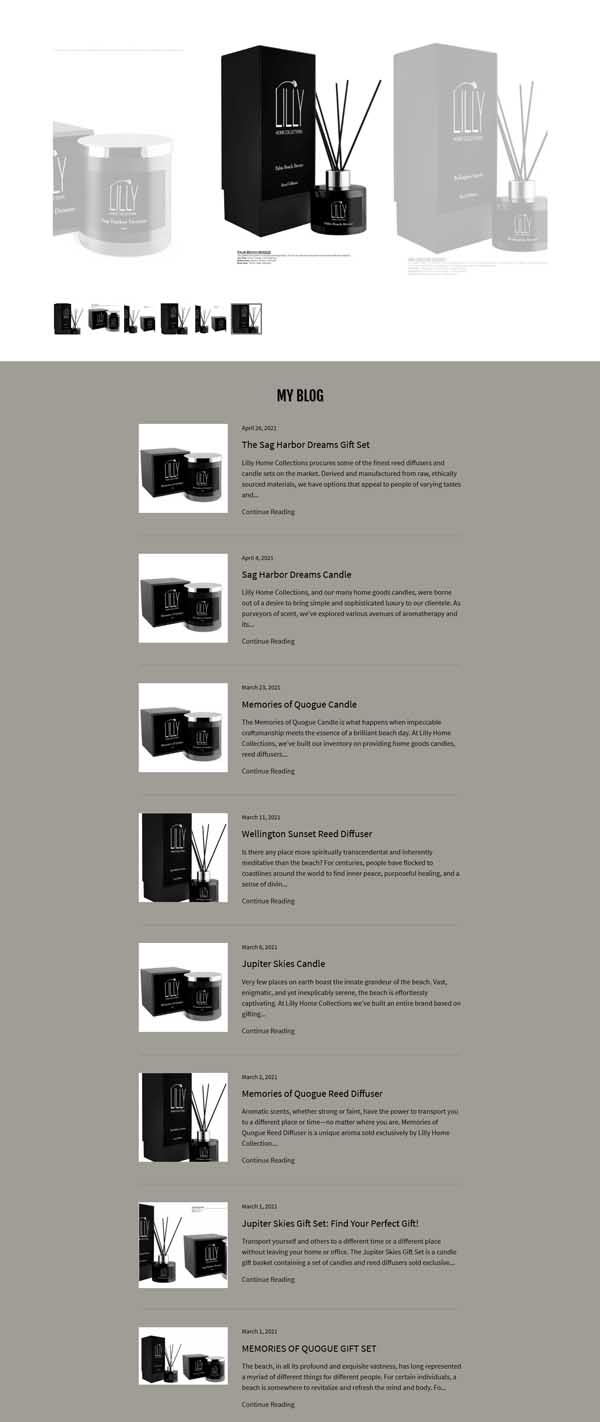
Fragrance company Lilly Home Collections has an elegant and clean blog page. It pairs a professional photo with each blog post to clearly highlight the product the post discusses, making it easy for readers to know which post they want to read.
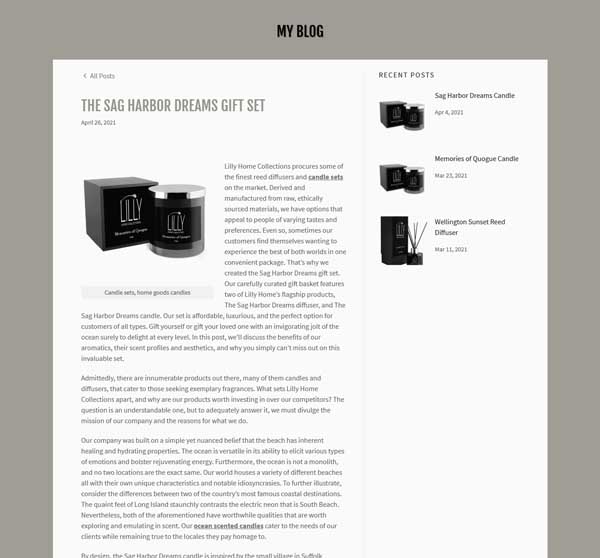
The layout of each blog post includes an image of the featured item at the top along with links to other recent posts in a right-hand column. This enables readers to navigate the site with ease while also providing a large amount of information about the company’s products.
Lilly Home Collections also does a great job of keeping all of its blog posts on task and product-focused. This helps support the main goal of both its blog and website: to sell the company’s candles and diffusers.
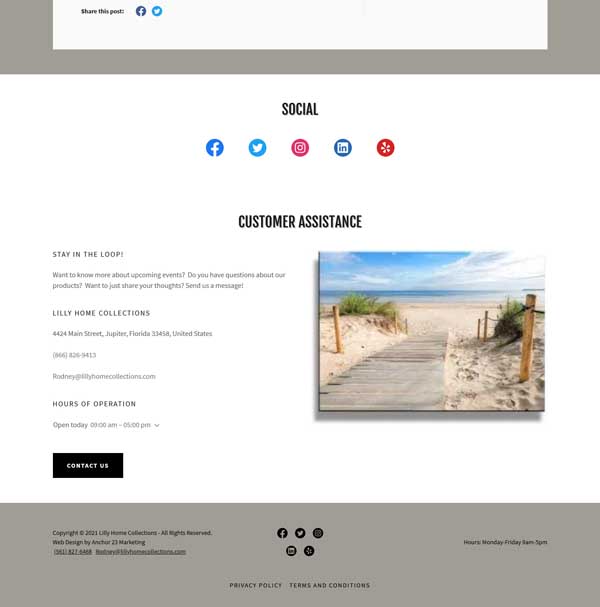
Each blog post ends with icons that enable readers to share it on Facebook and Twitter, helping the company further expand its reach. Below each post, a set of social media icons encourages readers to follow Lilly Home Collections on those platforms. The blog page also offers several different ways for readers to reach out to the company.
Overall, Lilly Home Collections does a great job of using several key elements to create a strong and successful blog page.
Get inspired to build your website and blog with GoDaddy by checking out these other GoDaddy website examples.
Best Wix Blog Page Example
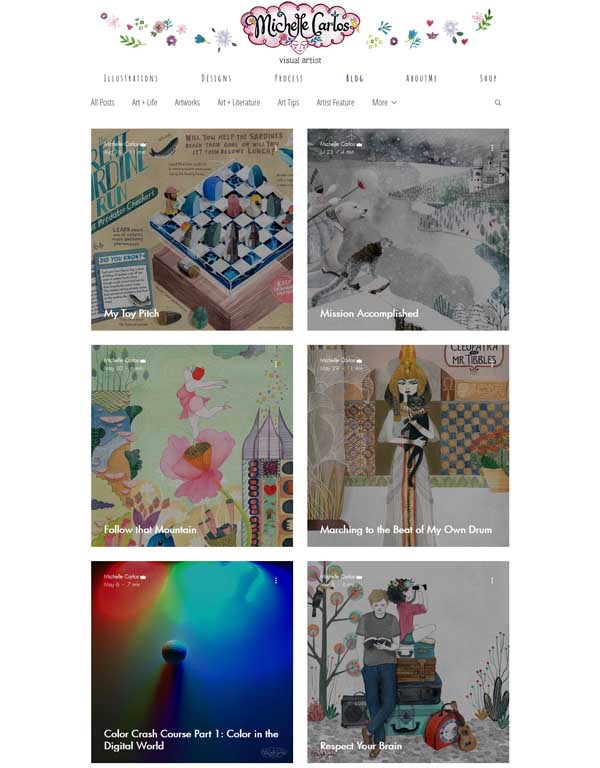
Visual artist Michelle Carlos uses her blog to showcase many of her talents and keep readers involved with her process. At the top of this blog page example, a navigation menu makes it easy for readers to narrow their search to posts that most align with their interests.
By using images to accompany each post title, as well as throughout her blog, Carlos does a great job of breaking up long posts to keep them engaging.
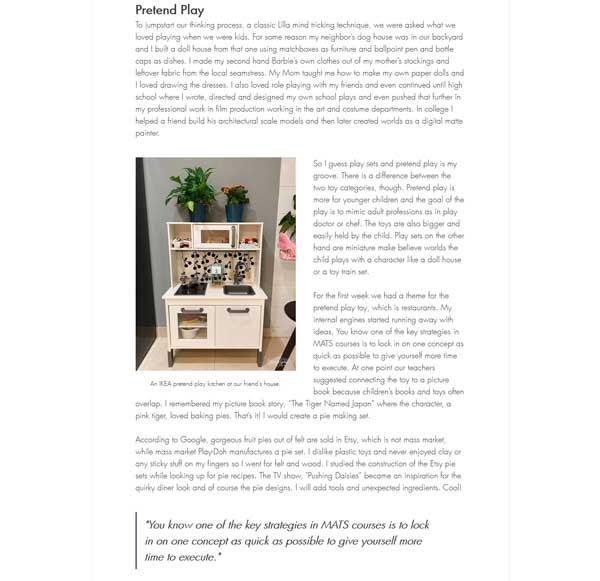
Carlos also uses different text sizes and text that visually wraps around images throughout her posts. This makes even very long entries feel inviting and easy to digest. Moreover, Carlos pairs personal details with industry knowledge to make her posts feel intimate and informative.
At the footer of each blog post, readers will find social media icons they can click on to easily follow Carlos across several platforms. This well-designed blog does a wonderful job of supporting the goals of the artist behind its content.
Get inspired to build your website and blog with Wix by checking out these other Wix website examples.
Best Shopify Blog Page Example

Sewing kit company Klum House gives people the tools they need to make their own bags from the comfort of their homes. This blog page example does an excellent job of highlighting both the company and information relevant to the products it offers.
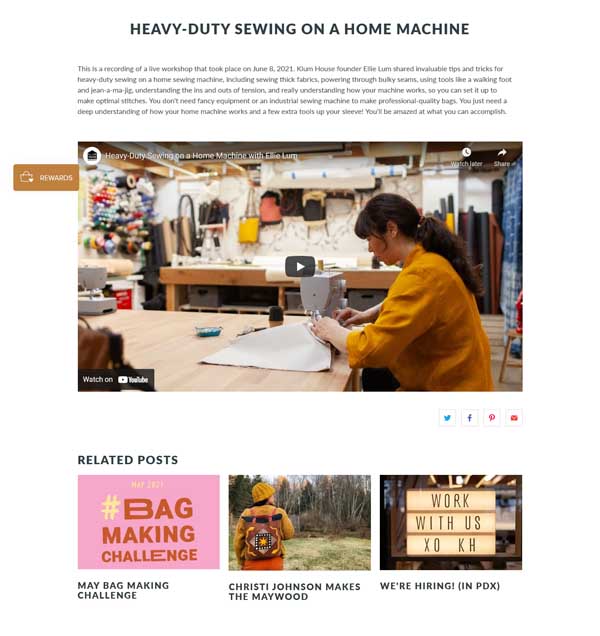
Using a video to make this blog post an informative tutorial is a great example of a company understanding its target audience. The set of social media icons right beneath the video also enable readers to easily share the post. In addition, grouping other related posts directly below the video helps this company continue to provide information to readers looking for more.
Need more blog design inspiration? View more blog page examples for Shopify online stores by checking out these other Shopify website examples.
Best WordPress Blog Page Example
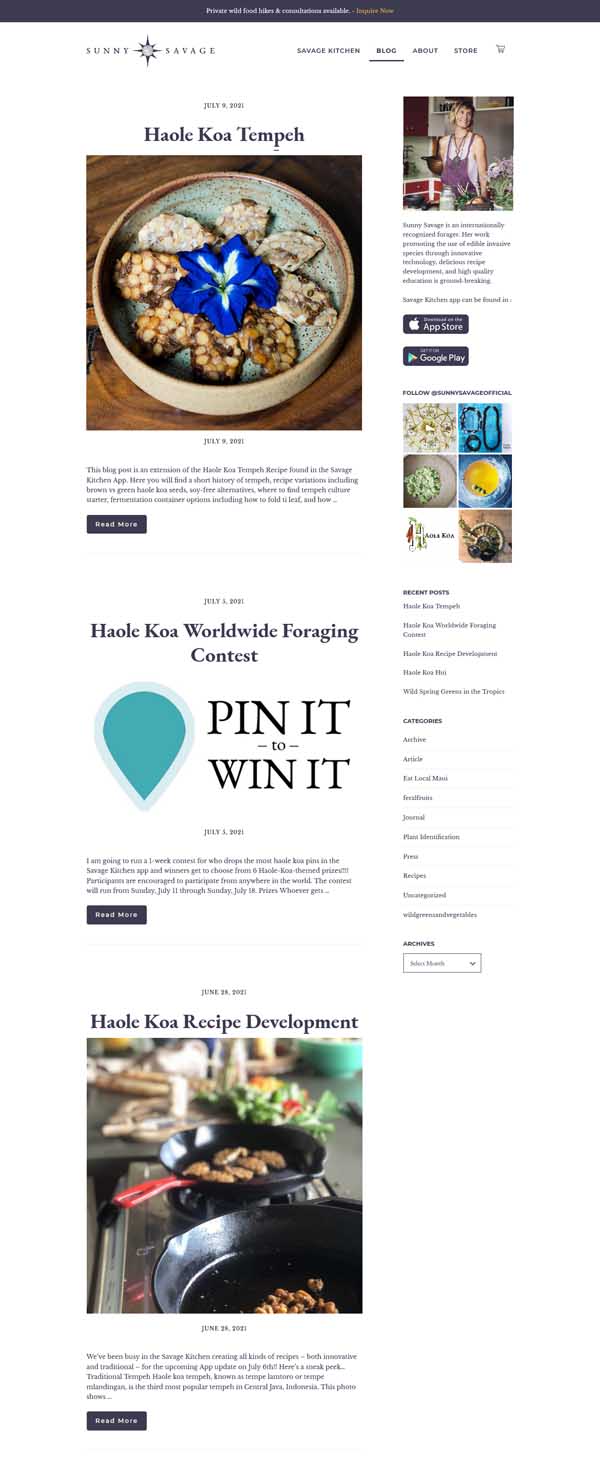
Forager-on-a-mission Sunny Savage uses her blog page design to promote edible invasive species — as well as how to find and prepare them. Each blog post also does a great job of supporting a key goal of her website: getting readers to download and use her app.
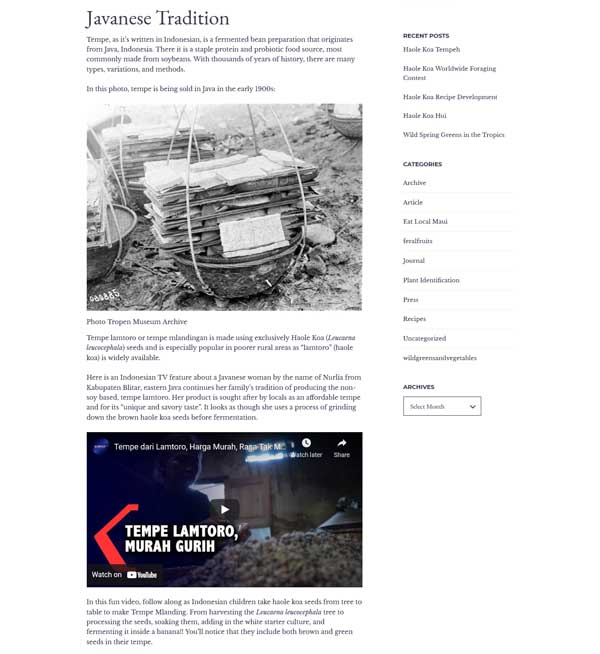
Savage uses a mix of photos and videos to provide in-depth information about the plant and process she explores in each post. This approach helps her tell the story of that plant’s origins as well as how to adapt recipes to meet the needs of the reader. It also highlights the author’s diligence and an effective technique for building trust with an audience. Her expertise seems trustworthy because of all the background knowledge she provides.
Along the right-hand side of each blog post, readers will find lists of recent posts, categories of posts, and archives. This allows them to move about the blog with ease to find other posts that may interest them.
This blog page design also features several CTA buttons that invite readers to download the Savage Kitchen app and continue engaging with the mission of the blog and website. Each post also includes a comments section.
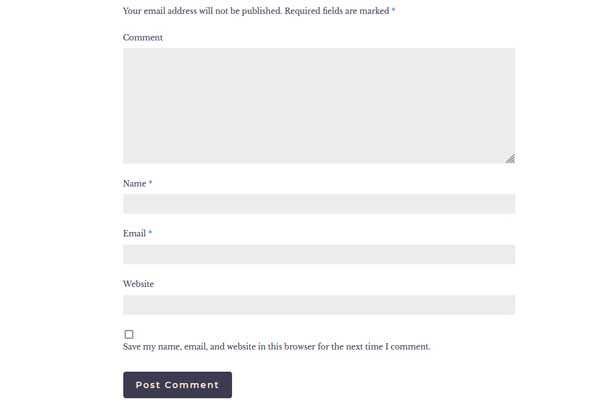
To add a comment, users must complete a contact form. This provides a great tool for collecting visitor information and tracking return readers because readers can save their information to apply to future comments.
View other blog design examples for WordPress by checking out these other WordPress website examples.
Best Weebly Blog Page Example
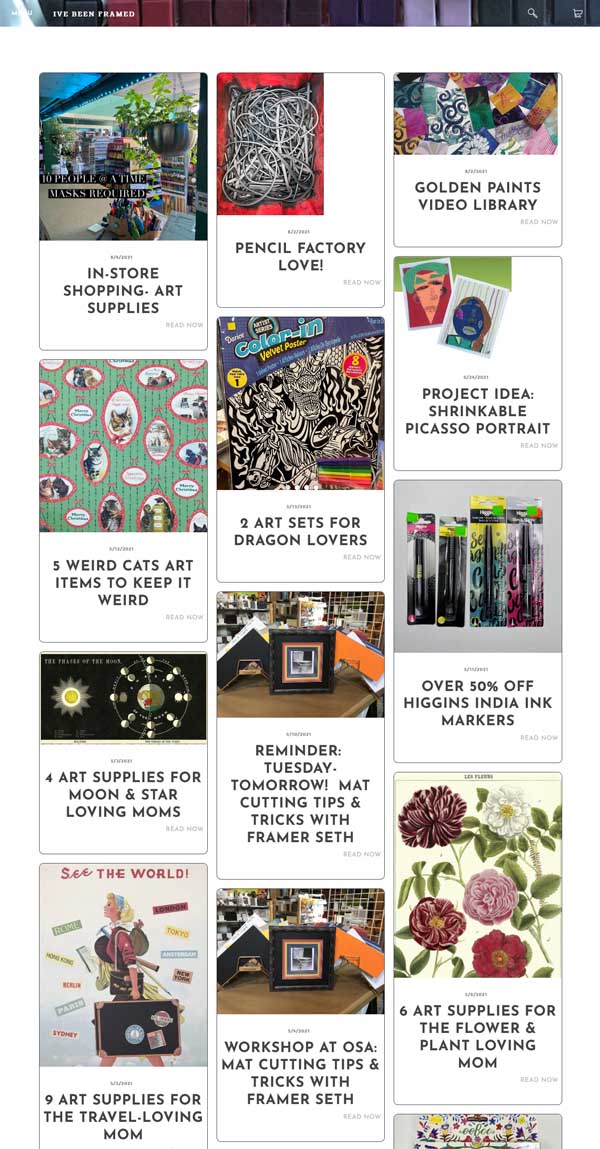
Art supply store I’ve Been Framed uses its blog to update readers on new arrivals and any changes to its shopping policies, among other topics. Its posts range from behind-the-scenes stories to unique insights on the ever-evolving art world, in general.
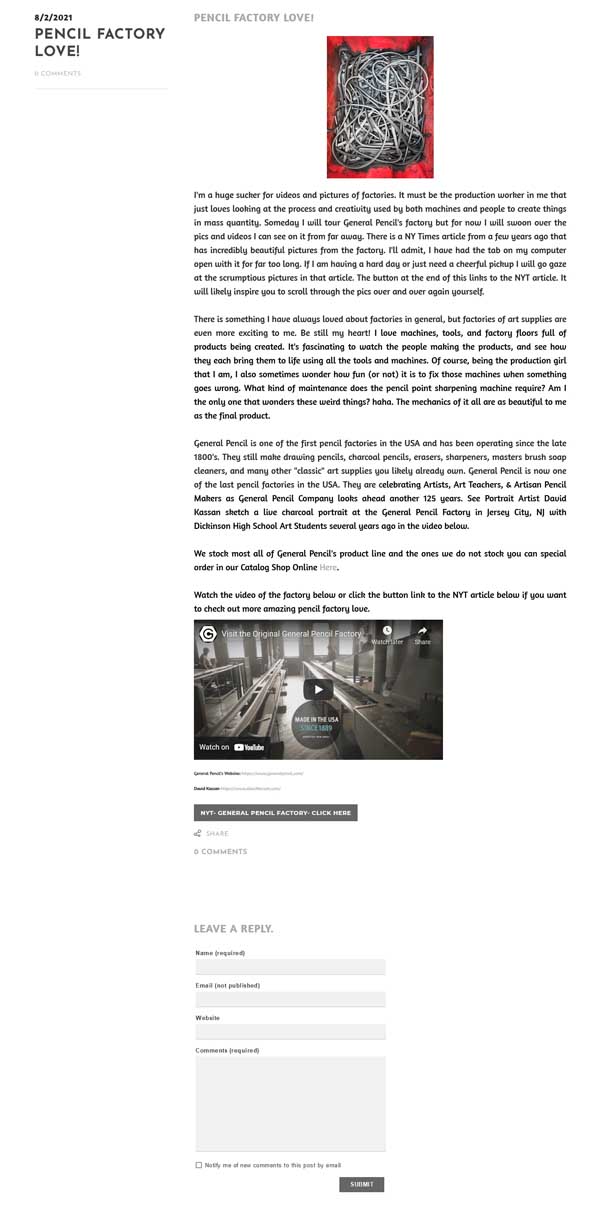
I’ve Been Framed does a great job at keeping its posts brief, yet engaging while using both images and videos to highlight the depth of what those posts discuss. These posts also include internal links to this website’s product page as well as ways for customers to order the items discussed in each post.
Each post features a contact form at the end to encourage comments — another successful element that helps this small business track its readers and subscribers.
Get inspired to build your website and blog with Weebly by checking out these other Weebly website examples.
Best Squarespace Blog Page Example

Somatic practitioner and educator Stevie Leigh of Weaver + Rose Healing uses their blog to explore topics related to their practice. The blog also encourages readers to subscribe to Leigh’s account on the Patreon membership platform to gain first access to these musings.
Breaking up each post with a mixture of images, different font sizes, and wrap-around text, Leigh understands how the human eye travels a web page and what readers of this blog seek. Many posts encourage personal journaling, sitting with responses, and keeping the writing in the mind of the reader.
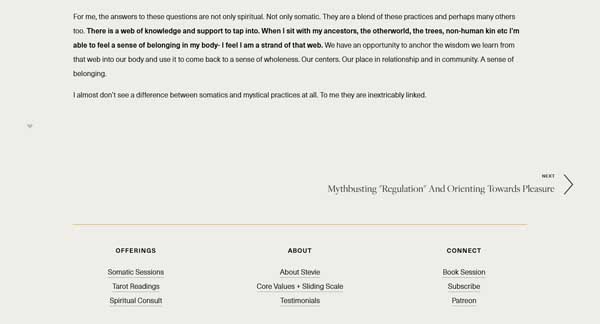
Each blog post ends with a linked headline that encourages readers to move on to the next post — a useful tool for keeping visitors engaged and ready to learn more. The footer also includes helpful information, making it easy for site visitors to find the information they seek. Overall, the team behind Weaver + Rose Healing’s blog design took great care to ensure visitors have a pleasant and intuitive blog experience.
Get inspired to build your website and blog with Squarespace by checking out these other Squarespace website examples.
Final Thoughts
Now that you have the building blocks to begin creating a successful blog page for your business website, it’s time to find the right website builder. Read our Best Website Builder review to determine which platform will suit your needs as you grow your blog and business.
Check out these other articles to learn more about how to create a successful business website and achieve your business goals:


